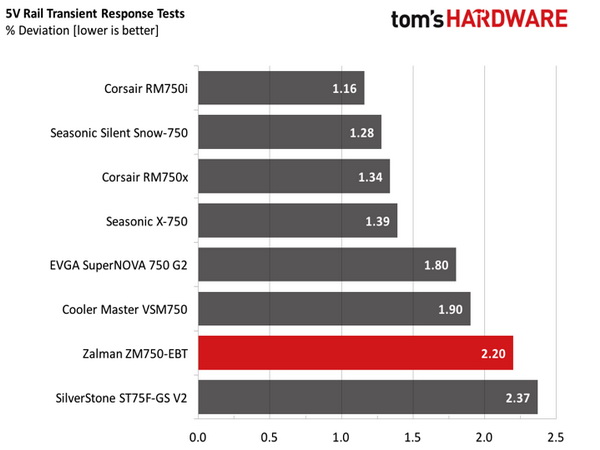Zalman ZM750-EBT PSU Review
Zalman's new EBT line consists of four PSUs ranging from 650W to 1kW capacity. Today, we're testing the ZM750-EBT, which, thanks to a low price, achieves a good value score. But how does it fare in terms of absolute performance?
Why you can trust Tom's Hardware
Transient Response Tests
Advanced Transient Response Tests
For details on our transient response testing, please click here.
In these tests, we monitor the response of the PSU in two different scenarios. First, a transient load (10A at +12V, 5A at 5V, 5A at 3.3V and 0.5A at 5VSB) is applied to the PSU for 200ms while the PSU works at 20 percent load. In the second scenario, the PSU is hit by the same transient load while operating at 50 percent load. In both tests, we use our oscilloscope to measure the voltage drops caused by the transient load. The voltages should remain within the ATX specification's limits.
These tests are crucial because they simulate the transient loads a PSU is likely to handle (such as booting a RAID array or an instant 100 percent CPU/GPU load). We call these tests "Advanced Transient Response Tests," and they are designed to be tough to master.
Advanced Transient Response at 20 Percent
| Voltage | Before | After | Change | Pass/Fail |
|---|---|---|---|---|
| 12V | 12.253V | 12.125V | 1.04% | Pass |
| 5V | 5.090V | 4.982V | 2.12% | Pass |
| 3.3V | 3.340V | 3.216V | 3.71% | Pass |
| 5VSB | 5.139V | 5.095V | 0.86% | Pass |
Advanced Transient Response at 50 Percent
| Voltage | Before | After | Change | Pass/Fail |
|---|---|---|---|---|
| 12V | 12.188V | 12.056V | 1.08% | Pass |
| 5V | 5.055V | 4.940V | 2.27% | Pass |
| 3.3V | 3.304V | 3.183V | 3.66% | Pass |
| 5VSB | 5.101V | 5.041V | 1.18% | Pass |





The +12V rail performs well enough, and the same applies to the 5V and 5VSB rails as well. At 3.3V the deviations are significant, though during the first test we observed this rail keeping its voltage above 3.2V. Only during the second test did it drop lower, costing the PSU performance points in our final rating.
Here are the oscilloscope screenshots we took during Advanced Transient Response Testing:
Transient Response At 20 Percent Load




Transient Response At 50 Percent Load




Turn-On Transient Tests
In the next set of tests, we measured the response of the PSU in simpler transient load scenarios—during the PSU's power-on phase.
For the first measurement, we turned off the PSU, dialed in the maximum current the 5VSB could output and switched on the PSU. In the second test, we dialed the maximum load the +12V could handle and started the PSU while it was in standby mode. In the last test, while the PSU was completely switched off (we cut off the power or switched off the PSU by flipping its on/off switch), we dialed the maximum load the +12V rail could handle before switching on the PSU from the loader and restoring the power. The ATX specification states that recorded spikes on all rails should not exceed 10 percent of their nominal values (+10 percent for 12V is 13.2V, and 5.5V for 5V).
Get Tom's Hardware's best news and in-depth reviews, straight to your inbox.



During the first two tests, the slopes were very smooth. Only during the last test did we notice a small drop before the rails settled down to their nominal voltage. This is nothing to worry about, and in general Zalman performed quite well here.
Current page: Transient Response Tests
Prev Page Cross-Load Tests And Infrared Images Next Page Ripple Measurements
Aris Mpitziopoulos is a contributing editor at Tom's Hardware, covering PSUs.